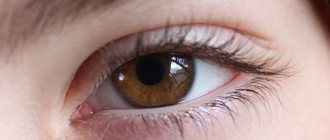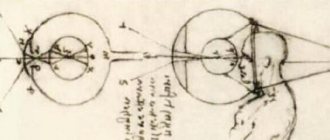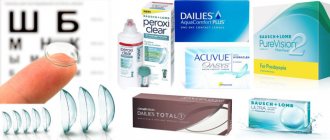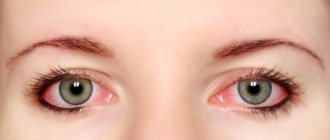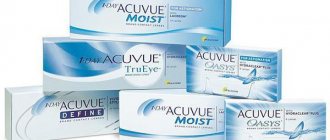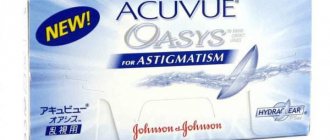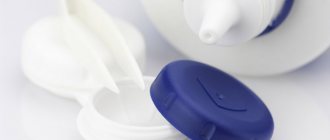Vision glasses: advantages and disadvantages
As a rule, primary vision correction is always glasses
. That is, if your vision has deteriorated, the first thing they will do is give you glasses, and only then contact lenses. Glasses are easier to care for, but their advantages don’t stop there.
Advantages
- Long lasting – Unlike lenses that need to be replaced regularly, glasses can last until you need more correction. But this is only possible if you handle your glasses with care and avoid scratches and scuffs;
- From a savings point of view, glasses are more profitable because they do not require constant updating and do not require additional accessories, whereas you will have to regularly purchase additional care products for lenses;
- Glasses are more convenient for wearing at home: to put on glasses, you don’t need to spend a lot of time and worry about hand hygiene;
- Goggles protect your eyes in windy weather. Dust that gets into your eyes can cause irritation, which can develop into inflammation. People who wear glasses do not experience such problems;
- Glasses with trendy frames can become a fashion accessory that sets the tone for the entire look;
- People with glasses are perceived as intellectuals. This is used even by those who do not need vision correction - in this case they use glasses without diopters.
Glasses are easier to care for and cheaper
However, with all the advantages, glasses also have a number of disadvantages.
Sign up for a free glasses selection
Flaws
- With complex prescriptions, glasses will not provide 100% vision correction. As a rule, this problem occurs in people with a large difference in visual acuity between the right and left eyes. The maximum permissible difference between lenses in glasses is 3 diopters, and then only for people with a high level of adaptability. Thus, if the actual difference between the eyes is more than 3 diopters, one eye receives incomplete correction;
- A person wearing glasses experiences discomfort during rain or in cold seasons, when the glasses fog up when entering a warm room from the cold. This problem can be solved by a special hydrophobic coating - thanks to it, raindrops roll down the lens without leaving marks, and fogging goes away within a few seconds. However, this coating is not suitable for all lenses;
- Also, glasses are uncomfortable during sports and other active leisure activities. For professional sports, you can order special glasses with a sporty design; they are securely fixed on the face and provide additional protection to the eyes. However, not everyone is ready to order such glasses. If you just want to go dancing or do yoga at home, wearing glasses can be problematic;
- Although glasses last longer than lenses, this does not mean they last forever. Glasses wear out, frames can loosen and peel, and lenses can become scratched. If not handled carefully, this happens very quickly;
- Even if you order glasses with rimless frames, they will be visible on your face. Not everyone likes to see themselves in glasses.
Types of lenses
There are many lenses available on the ophthalmic market today. It is difficult for an ignorant person to understand their diversity. First you need to know what they are and what they may be intended for.
In general, all lenses can be divided into two large groups: hard and soft.
Modern hard contact lenses are made from hard polymers individually for each patient. These lenses are very durable and correct vision well. However, they do not allow oxygen to pass through well, and are therefore less comfortable than their soft “brothers”. Only 10% of patients use rigid models. However, hard contact lenses cannot be discounted, as they are indispensable for certain types of eye diseases.
You can read more about the selection and care of hard contact lenses in this material.
Crazy carnival lenses
Soft contact lenses are much more popular. They differ in hydrophilicity (moisture content level). There are lenses with low moisture content (38-45% water) and lenses containing 60-90% water.
Gas permeability (or oxygen permeability) is a very important parameter for lenses, which is indicated by the DK coefficient. The higher this indicator, the higher the resistance of the lenses to various types of lipid deposits.
According to the wearing mode, there are lenses:
- daytime wear (removed at night);
- prolonged wearing (can be left on for up to 7 days);
- continuous wearing (without removing at night for up to 30 days);
- flexible wearing (sometimes can be left overnight);
- night lenses (wear only at night).
Scheduled replacement contact lenses
Depending on the timing of replacement, lenses differ:
- one-day (changes every day);
- planned replacement (from 2 weeks to 3 months);
- traditional (wearing period from 6 to 12 months).
This article will tell you everything about Acuvue 1 Day Trueye contact lenses.
The lenses differ in design:
- spherical;
- aspherical;
- toric;
- multifocal;
- keratoconus, etc.
Toric contact lenses
The main difference between aspherical and spherical lenses is their surface shape and radius of curvature. But their indications for use are similar.
Toric lenses have different optical powers in the two meridians. One of them corrects astigmatism, and the other corrects myopia or hypermetropia. The special shape of the toric lens ensures its stability on the eye in the required position.
What is astigmatism and how to treat it you will learn from this material.
The principle of operation of multifocal (bifocal and progressive) contact lenses is almost the same as that of glasses. They contain several zones responsible for better vision at distance, mid-distance and near. These lenses are recommended for patients with presbyopia (age-related farsightedness).
Multifocal (progressive) contact lenses
According to their intended purpose, contact lenses are divided into:
- optical;
- therapeutic;
- cosmetic;
- decorative.
One of the varieties of decorative lenses are carnival ones, read more about them here.
The first ones are intended for the correction of refractive errors (myopia, astigmatism, farsightedness, presbyopia).
Therapeutic contact lenses are used as a bandage to protect the cornea in case of lesions, and also as a reservoir for medicinal substances. They help in the treatment of various corneal diseases.
Cosmetic contact lenses are used to hide various congenital or acquired eye defects. It can be:
- corneal opacities;
- absence of the iris (aniridia);
- absence of lens (aphakia);
- lack of iris color (albinism);
- when the eyes are different colors (heterochromia of the eyes);
- absence of part of the iris (coloboma), etc.
Soft contact lenses
Soft contact lenses are also used to protect vision from ultraviolet radiation and are recommended for patients after removal of the lens for cataracts.
Pros and cons of contact lenses
Contact lenses are more aesthetically pleasing and are suitable for those who do not want to wear glasses. What other advantages do lenses have?
Advantages
- The lenses provide 100% vision correction. Due to the fact that the lenses are placed directly on the cornea, any difference between diopters is allowed. Thanks to this, people with large differences in visual acuity of different eyes receive complete and adequate correction;
- Unlike glasses, contact lenses do not limit your field of vision. With glasses, the field of view is limited, causing people to have to turn their head to see something from the side. For those who wear contact lenses, it is enough to look away;
- Regardless of diopters, lenses do not distort surrounding objects and do not affect the perception of their size, unlike glasses, which can transmit images with serious distortion (relevant for glasses that correct high degrees of myopia or hypermetropia);
- If you wish, you can order colored contact lenses and use them to change your eye color;
- The lenses are comfortable at any time of the year and in any weather. They are also comfortable to play sports and lead an active lifestyle.
Lenses provide more options for vision correction and an active lifestyle
Lenses are a truly convenient and modern method of vision correction. But lenses do not tolerate a careless attitude, which can result in health problems.
Sign up for a free selection of contact lenses
Flaws
- Lenses require careful care. You need to clean the container and the lenses themselves daily, but do not rinse with water. Negligence in cleaning lenses and containers can lead to infection of the eyes, penetration of pathogenic bacteria into the mucous membranes and the development of serious pathologies;
- Before any contact with lenses, you should wash your hands with antibacterial soap. This can be a serious problem if you are outdoors and a piece of debris gets into your eye. If bacteria or infection gets onto the lens from dirty fingers, this will lead to eye disease;
- If the wearing regimen is not followed, disorders such as dry eye syndrome or corneal hypoxia may develop;
- Lenses require more spending. In addition to regularly updating the lenses themselves, it is necessary to buy lens solution monthly and also periodically change tweezers;
- Some people have trouble putting on contact lenses, they cannot cope with the reflex blinking and can damage the lens;
- During allergic attacks or colds, the use of contact lenses is prohibited.
Buy contact lenses at a good price
Are there any disadvantages to constant wear lenses?
Contact lenses come into direct contact with the shell of the eye, so they require careful handling. You will have to purchase a special solution for lenses to ensure proper storage, and change your pair of lenses once a month. In addition, you will have to monitor your health more closely: there is no need to take out lenses that you wear constantly before going to bed, but if discomfort occurs, you should not ignore it! You should also have your vision checked by an ophthalmologist every six months.
Take care of yourself, and contact lenses will help you regain full vision without any discomfort. Proper care of them can avoid any harm to the eyes and prevent further deterioration of vision. Modern silicone hydrogel lenses for permanent wear can be worn around the clock: thanks to their special structure, they do not cause hypoxia and do not worsen well-being.
Lenses or glasses: advice from doctors
Ophthalmologists do not give a clear answer to this question. Each case is individual, and the final decision about which correction method should be chosen will depend on a number of factors:
- Client's preferences;
- Presence of contraindications to the use of contact lenses;
- Features of vision and eye condition.
At the same time, experts note that it is best to combine glasses with lenses, provided that there are no contraindications. This way you will get a full correction without distortion, while the risk of overwearing the lenses and possible negative consequences is minimized.
How to avoid problems associated with contact lens use
The diseases listed above and many others associated with wearing lenses can be easily avoided if the patient regularly (at least once a year) visits the ophthalmologist for a vision test and a new selection of lenses, if necessary.
Each type of lens requires its own care. It is necessary to strictly follow the rules for caring for your type. If you have any doubts about how to clean, store, or simply handle your lenses, it is best to seek professional advice.
It is also important to follow the lens wearing regime. You cannot extend their use on your own, as damage or plaque may form on the lens, not visible to the naked eye, but clearly visible under a microscope, which will lead to problems with the cornea.
Minuses
1. Contact lenses are not suitable for everyone. People with very sensitive eyes cannot tolerate friction from the lens. Which lenses are better to choose? Read in this article.
2. Lenses require careful care: washing, changing the solution, removing them at night, regularly replacing them with new ones. These are quite troublesome procedures, and if violated, unpleasant symptoms often occur: eye pain, redness, dryness and discomfort. Perhaps this is the most unpleasant aspect of the issue. Removing and putting on lenses is a whole ritual that must be followed. It will take patience.
3. Doctors do not recommend children wear lenses to avoid eye damage when putting them on and taking them off.
4. Often people who use contact lenses notice redness in their eyes. This may be due to improper operation, contamination, or improper replacement. Red eye syndrome can occur due to intolerance to the lens care solution or insufficient oxygen supply to the cornea of the eye. If this syndrome occurs, you need to stop wearing lenses until the reasons are determined, which an ophthalmologist can help determine.
Using colored lenses causes eye pain more often than using regular ones. As a rule, this is due to the fact that they are made of low-quality material and are not suitable for a person, rubbing the eyes. It is important to understand that not everyone can tolerate wearing contact lenses, and their improper use can lead to serious complications.



